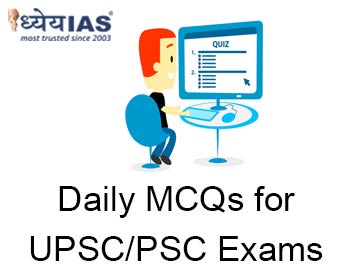Home > Daily-mcqs
Daily-mcqs 16 Oct 2025

Q1:
1. It is the first elephant population estimation in India to use DNA-based methods. 2. The total estimated wild Asian elephant population in India is over 25,000. 3. It shows a decline in population compared to the 2017 estimation. Which of the above statements is/are correct?Consider the following statements regarding the All India Elephant Estimation (SAIEE) 2021–25:
A: 1 and 2 only
B: 1 and 3 only
C: 2 and 3 only
D: 1, 2, and 3
Answer: B
Explanation:
Statement 1 is correct: SAIEE 2021–25 is India's first DNA-based elephant census.
Statement 2 is incorrect: The estimated population is 22,446, which is below 25,000.
Statement 3 is correct: The population declined from 27,312 in 2017 to 22,446, a drop of 17.8%.
Q2:
1. The Asian elephant is listed as Endangered on the IUCN Red List. 2. It is protected under Schedule I of the Wildlife Protection Act, 1972. 3. It is included in Appendix II of CITES. Which of the statements given above is/are correct?Consider the following statements about the Asian elephant in India:
A: 1 and 2 only
B: 2 only
C: 1, 2 and 3 only
D: None
Answer: A
Explanation:
Statement 1 is correct: The Asian elephant (Elephas maximus) is listed as Endangered on the IUCN Red List.
Statement 2 is correct: It is protected under Schedule I of the Wildlife Protection Act, 1972, giving it the highest level of protection.
Statement 3 is incorrect: It is listed under Appendix I of CITES, not Appendix II. Appendix I offers the strictest international trade restrictions.
Q3:
1. Climate change is now considered the second largest current threat to natural World Heritage sites. 2. Invasive alien species (IAS) affect a larger percentage of sites than climate change. 3. Wildlife and plant diseases have shown an increase in threat levels since 2020. Which of the above statements is/are correct?Consider the following statements regarding the IUCN World Heritage Outlook 4:
A: 1 only
B: 3 only
C: 1, 2 and 3 only
D: None
Answer: B
Explanation:
Statement 1 is incorrect: The report clearly states climate change is the largest current threat of natural world heritage sites, impacting 43% of sites, not second largest threat.
Statement 2 is incorrect: Invasive alien species (IAS) affect 30% of sites, which is less than climate change.
Statement 3 is correct: Threats from wildlife and plant diseases have risen from 2% in 2020 to 9% now
Q4:
1. Arunachal Pradesh reported the highest SRB among all Indian states. 2. The SRB in Jharkhand and Bihar was below the national average. 3. A low SRB reflects a potential violation of the PCPNDT Act. Which of the above statements is/are correct?Consider the following statements about the Sex Ratio at Birth (SRB) reported in 2023:
A: 1 and 2 only
B: 1 and 3 only
C: 2 and 3 only
D: 1, 2, and 3
Answer: D
Explanation:
Statement 1 is correct: Arunachal Pradesh had the highest SRB (1,085) in 2023.
Statement 2 is correct: Jharkhand (899) and Bihar (900) had SRBs below the national average and below the natural SRB (usually around 950–975).
Statement 3 is correct: Persistently low SRBs can indicate gender-biased sex selection, often linked to violations of the PCPNDT Act, which bans sex-selective abortions.
Q5:
Consider the following statements about Mongolia’s geography: 1. The Gobi Desert in Mongolia consists primarily of vast sand dunes. 2. Mongolia's highest peak, Khüiten Peak, is located in the Altai Mountains. 3. Lake Khövsgöl, the largest freshwater lake in Mongolia, lies in the southern part of the country. Which of the statements given above is/are correct?
A: 1 and 2 only
B: 2 only
C: 1 and 3 only
D: 1, 2, and 3
Answer: B
Explanation:
Statement 1 is incorrect: The Gobi Desert is not primarily composed of sand dunes. It includes stony, rocky, and sandy plains, with fewer sand dunes than typical deserts.
Statement 2 is correct: Khüiten Peak (4,374 m) is the highest point in Mongolia, located in the Altai Mountains in the west.
Statement 3 is incorrect: Lake Khövsgöl is located in northern Mongolia, not the south.